University Hall
Introduction
Text-to-speech Audio
Images
University Hall (image from Historic Markers Database)
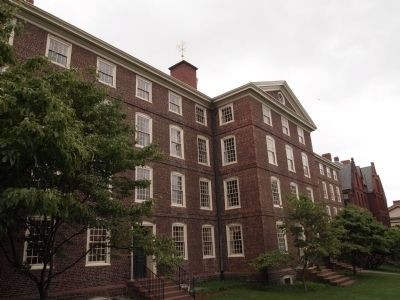
University Hall Historic Marker (image from Historic Markers Database)
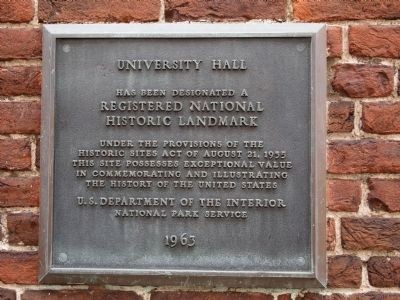
University Hall Historic Marker (image from Historic Markers Database)
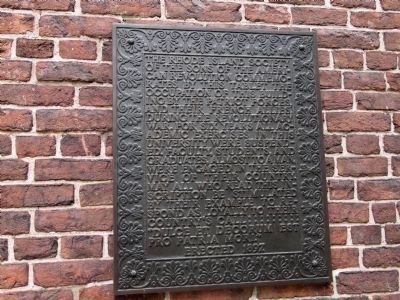
University Hall Historic Marker (image from Historic Markers Database)
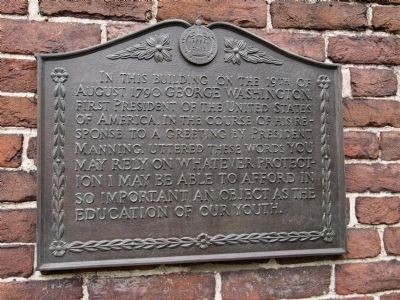
Engraving depicting University Hall and the President's House, c. 1845 (image from Hometalk)
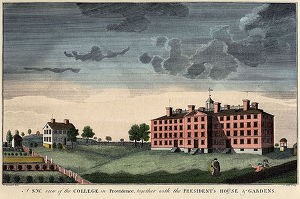
Backstory and Context
Text-to-speech Audio
Brown University was founded in 1764 as the College of Rhode Island, located in Warren, Rhode Island. It was the seventh college in Colonial America, and the first Ivy League institution to accept students regardless of religious affiliation. The institution relocated to a tract of land which had once belonged to Chad Brown, in Providence, holding classes at the Brick Schoolhouse (see the Meeting Street School) as a temporary measure. The same year, the Providence Gazette ran an advertisement for the college's building committee, requesting donations of building materials.
Merchant and amateur architect Joseph Brown, the great-great-grandson of Chad Brown, was a member of the building committee, and drew up the plans for the College Edifice. The late Georgian-style building was modeled on Nassau Hall of Princeton University, the alma mater of Brown University's first president, James Manning. Construction was undertaken by Nicholas Brown and Company, which included brothers Joseph, John, and Nicholas. On May 14, 1770, John Brown, laid the first cornerstone of the College Edifice. In just over a year and for less than $10,000, the first two floors were ready to house the 1771-1772 class of twenty-one students; the college would wait to finish the upper floors until the space was needed.
The American Revolution interrupted both the construction and the coursework of the new college, however. In December of 1776, British troops seized Newport and Aquidneck Island, within sight of College Hill. President Manning suspended university activities in a notice published in the Providence Gazette, shortly after he was informed that the College Edifice was to be commandeered as a barracks for the American Militia. In September of 1777, the graduating seniors were awarded their degrees, but Manning stated in another issue of the Gazette that the college would not reopen until hostilities ceased. Manning hoped to re-open when the American troops departed in 1780, but on June 5, Governor William Greene II notified the college president that the Edifice was to be used as a hospital for allied French troops.
Several students were tutored personally by Manning in his own house and, possibly, at the Brick Schoolhouse, earning their degrees in 1782. The same year, the French troops departed the College Edifice, and the damage to the building could be fully assessed. The college's Corporation assessed the damage at $4,400 and submitted a bill to the new Federal government for the cost. The American occupancy alone had caused over $2,000 in damages, and the French nearly dismantled the building, planning to strip and sell the boards and windows. An attached stable had been stripped of every "window, hinge, lock and valuable piece of lumber that could be removed," [2]. The college was reimbursed only $2,779.13, and not until eighteen years after the bill was sent.
Nevertheless, the college reopened, with sufficient enrollment to warrant the finishing of the third floor in 1785 and the fourth floor in 1788. Nicknamed the "Old Brick" by students, the College Edifice contained the dormitory, library, chapel, dining hall, and classrooms of the school. Even the tutors, the steward, and many of the professors lived in the "Old Brick." In 1888 and 1889, respectively, the college awarded its first Master's degrees and Doctorates. On the evening of August 18, 1790, President George Washington and his Secretary of State, Thomas Jefferson, visited the building. To welcome the First President, students lit candles in the windows of the Edifice; it has since become a university tradition to light the windows on ceremonial occasions. After his visit, Washington was awarded an honorary doctorate.
After the death of John Brown, his nephew Nicholas Brown donated $5,000 to the college in accordance with his uncle's wishes. Nicholas Brown was an alumnus of the school, having graduated in 1786, and donated liberally to the college throughout his lifetime. In gratitude, the College of Rhode Island was renamed Brown University in September of 1904. Until the addition of Hope College in 1822-1823, the College Edifice remained the only university building; when Hope was constructed, the Edifice was renamed University Hall.
The Hall continued to serve as a dormitory and lecture hall until 1940. Now, after a number of alterations and reconstructions, the exterior of University Hall has been restored to its 1771 appearance, and houses Brown's administrative center and the governing body of the University.
Historic Marker Inscriptions:[First Marker]
University Hall
Has been designated a Registered National Historic Landmark
Under the provisions of the Historic Sites Act of August 21 1935
This site possesses exceptional value in commemorating and illustrating the history of the United States
U.S. Department of the Interior
National Park Service
1963
[Second Marker]
The Rhode Island Society of the Sons of the American Revolution commemorates by this tablet the occupation of this building by the patriot forces, and their French allies, during the Revolutionary War. For six years all academic exercises in this university were suspended. Faculty, students, and graduates, almost to a man, were engaged in the service of their country. May all who read this inscription be stimulated by their example to respond as loyally to their country's call.
"Dulce et Decorum est Pro Patria Mori." Erected 1897
[Third Marker]
In this building on the 19th of August 1790 George Washington, First President of the United States of America, in the course of his response to a greeting by President Manning, uttered these words You may rely on whatever protection I may be able to afford in so important an object as the education of our youth.
